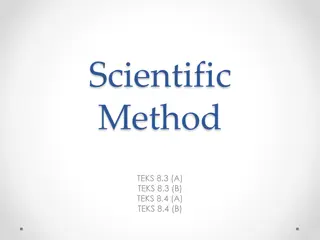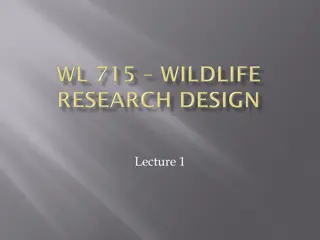Understanding the Scientific Method and Examples
The scientific method is a systematic approach to answering questions and solving problems. It involves steps like observation, asking questions, forming hypotheses, collecting data, organizing data, and drawing conclusions. This method helps researchers find answers efficiently and allows others to verify their findings. Two examples illustrate its application in real-life scenarios, highlighting how observations, questions, hypotheses, data collection, and conclusions are key elements in the scientific process.
Download Presentation

Please find below an Image/Link to download the presentation.
The content on the website is provided AS IS for your information and personal use only. It may not be sold, licensed, or shared on other websites without obtaining consent from the author. Download presentation by click this link. If you encounter any issues during the download, it is possible that the publisher has removed the file from their server.
E N D
Presentation Transcript
What is the scientific method? It is a strategy to answer a question or find information Doesn t have to be followed the same every time or for every experiment Always involves following steps in an order It doesn t make any sense to come to a conclusion without having done any observing first Following steps allows you to find your answer as quickly as possible without repeating yourself Following steps also allows other people to check your work if you discover something amazing!
What ARE the steps to use? Observation- you see something Ask a Question- Why? How? Form a Hypothesis Do some research. What could possibly explain your observation? How could you test your explanation? What do you expect to happen? Collect Data- conduct an experiment, do more observing, measure Organize your Data Draw a Conclusion
Example 1: Observation: There is a dog barking at a tree Question: Why is the dog barking at the tree? Hypothesis: I know dogs bark at strangers, and noises and other animals. Maybe there is an animal in the tree. If I bring the dog to a tree without an animal it shouldn t bark. If I show the dog a tree WITH an animal in it then it will bark. Collect Data: I put a cat in one tree and nothing in the other, the dog barked at the tree with the cat. The dog did not bark at the empty tree. Organize Data: Draw a Conclusion: There must have been something in the tree for the dog to bark at.
Example 2: Observation: My grades are better in my afternoon classes than my morning classes Question: Why are my grades better later? Hypothesis: If I am tired in the morning than my grades will be lower than in the afternoon. Collect Data: My last quiz grades in period one were 68, 46 and 62. After going to bed early for two weeks my quiz grades were 71 and 65. Quiz grades in period 9 were 71, 75 and 79. After two weeks my quiz grades were 82, 75.
Period 1 Period 9 Organize Data: Quiz Ave. Regular Quiz Ave W/Extra Sleep 59 75 68 79 Does more sleep help my quiz grades? 90 79 80 75 68 70 59 60 50 Quiz Ave. Regular 40 Quiz Ave. W/Extra Sleep 30 20 10 0 Period 1 Period 9
Draw a Conclusion: My Quiz average in period one increased by almost 10 points and supported my hypothesis. The extra sleep helped my late class quizzes as well, by about 4 points. I wonder if eating breakfast would help the morning quizzes too.
You DO: Choose one of the observations below and follow the scientific method to either SUPPORT IT or CONTRADICT it. 1. Girls are smarter than Boys 2. Randy Moss is a better wide receiver than TO 3. More practice time shooting free throw equals more points per game 4. The temperature at 11am is always colder then the temperature at 3pm 5. Girls text faster than Boys 6. Jason can throw a ball farther then Bill 7. Girls are better safer drivers than Boys 8. The taller the ramp, the farther you will coast on a bike























